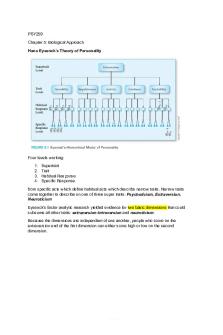Connecting concepts #5 PDF

| Title | Connecting concepts #5 |
|---|---|
| Author | Alex Amaya |
| Course | General Biology for Nonmajors |
| Institution | Florida State University |
| Pages | 2 |
| File Size | 75.5 KB |
| File Type | |
| Total Downloads | 41 |
| Total Views | 163 |
Summary
Mandatory assignment ...
Description
For each type of cell division… Is the parent cell a diploid or a haploid cell? How many daughter cells are produced from the division of one parent cell? Are the daughter cells diploid or haploid? Does the parent cell divide once or twice? Where in the human body is this type of cell division taking place? What is the physical arrangement of the chromosomes before the 1st (or only) cell division? (Single line? Homologous pairs?) Does crossing over (or recombination) happen before the 1st (or only) division? Does independent assortment happen before the 1st (or only) division? Did you observe this type of cell division during Lab #4 (sea urchins)? When?
How will you remember which term (mitosis or meiosis) corresponds to which cell division process? Come up with an effective way and describe it here.
Mitosis
Meiosis
Haploid
diploid
2
4
haploid
haploid
once
twice
In the cells of the human body Single pairs Yes crossing over happens
Ovaries and testis
Doesn’t happen I observed mitosis in the sea urchins during fertilization of the eggs and sperm Only separates once, the end result is 2 cells
Homologous pairs Yes recombinatio n happens Yes in the 1st division I observed meiosis when we added the sperms and eggs together.
Separates 2 different times, the end result is 4 cells
2a. When testosterone is produced in the testes the hormone LH is stimulated. After LH is stimulated, FSH and testosterone both stimulate the production of sperm. b. When testosterone travels through the body’s circulatory system to the brain, the hypothalamus is inhibited. The hypothalamus releases GnRH hormones which then trigger the release of FSH and LH hormones. c. I think that the male reproductive hormone cycle is an example of a positive feedback cycle because the brain sends signals to release different hormones throughout the body to the testes with the goal of releasing sperm. In the male reproductive system, the ultimate goal is to release sperm for fertilization and the body’s way of doing that is to continue the cycle and to intensify it until the goal is reached. d. The two major roles that both estrogen and progesterone play in a female reproductive hormone cycle are to inhibit further secretion of FSH and LH and to promote the thickening of endometrium. e. I think that the female reproductive system is an example of negative feedback because the body releases hormones that trigger levels of ovulation and a change in hormone levels. Due to the surges of hormone levels during ovulation, the body’s way of dealing with all these changes in the female system is by mensuration....
Similar Free PDFs

Connecting concepts #5
- 2 Pages

BSC1005 Connecting concepts #11
- 2 Pages

Connecting Concepts #2
- 1 Pages

Connecting-television-4
- 35 Pages

Lab 3.4 - Connecting Networks v6
- 4 Pages

Accounting Concepts
- 4 Pages

Concepts quizlet
- 16 Pages
Popular Institutions
- Tinajero National High School - Annex
- Politeknik Caltex Riau
- Yokohama City University
- SGT University
- University of Al-Qadisiyah
- Divine Word College of Vigan
- Techniek College Rotterdam
- Universidade de Santiago
- Universiti Teknologi MARA Cawangan Johor Kampus Pasir Gudang
- Poltekkes Kemenkes Yogyakarta
- Baguio City National High School
- Colegio san marcos
- preparatoria uno
- Centro de Bachillerato Tecnológico Industrial y de Servicios No. 107
- Dalian Maritime University
- Quang Trung Secondary School
- Colegio Tecnológico en Informática
- Corporación Regional de Educación Superior
- Grupo CEDVA
- Dar Al Uloom University
- Centro de Estudios Preuniversitarios de la Universidad Nacional de Ingeniería
- 上智大学
- Aakash International School, Nuna Majara
- San Felipe Neri Catholic School
- Kang Chiao International School - New Taipei City
- Misamis Occidental National High School
- Institución Educativa Escuela Normal Juan Ladrilleros
- Kolehiyo ng Pantukan
- Batanes State College
- Instituto Continental
- Sekolah Menengah Kejuruan Kesehatan Kaltara (Tarakan)
- Colegio de La Inmaculada Concepcion - Cebu








